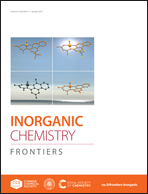Construction of brown mesoporous carbon nitride with a wide spectral response for high performance photocatalytic H2 evolution†
Abstract
Two-dimensional graphitic carbon nitride (2D CN) shows superior photocatalytic performance due to high charge separation efficiency and the rich active sites endowed with a 2D structure. However, the 2D structure also induces the weaknesses of easier agglomeration and wider bandgap which can weaken the H2 evolution capacity. Aiming to solve these defects, we prepared a brown mesoporous carbon nitride photocatalyst through phosphorus doping (BMCN). The phosphorus doping brings an excellent visible light response, a stable mesoporous structure with rich active sites, and a more negative CB potential. The optimized BMCN-50 shows a high H2 evolution rate of 2.7 mmol g−1 h−1 which is over 5 times than that of pure 2D CN. The apparent quantum yields (AQYs) of BMCN-50 at 420 nm, 435 nm, 450 nm, and 550 nm are 4.2%, 4.0%, 3.6%, and 0.5%, respectively, which are higher than those of 2D CN (3.2%, 0.9%, 0.2%, and 0%). Besides, BMCN showed stable H2 evolution performance even after being immersed in 10% TEOA solution for three months. This work presents an easy strategy to prepare a wide spectral response carbon nitride photocatalyst with a stable mesoporous nanostructure for more efficient photocatalytic H2 evolution reaction.

- This article is part of the themed collections: 2021 Inorganic Chemistry Frontiers Review-type Articles and 2021 Inorganic Chemistry Frontiers HOT articles


 Please wait while we load your content...
Please wait while we load your content...